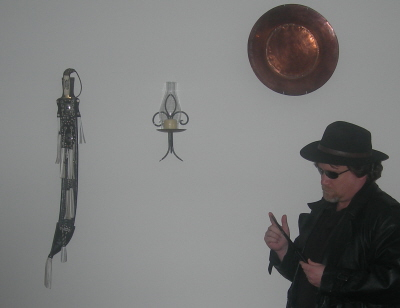|
About This Author
Come closer.
|
Complex Numbers
Complex Numbers
A complex number is expressed in the standard form a + bi, where a and b are real numbers and i is defined by i^2 = -1 (that is, i is the square root of -1). For example, 3 + 2i is a complex number.
The bi term is often referred to as an imaginary number (though this may be misleading, as it is no more "imaginary" than the symbolic abstractions we know as the "real" numbers). Thus, every complex number has a real part, a, and an imaginary part, bi.
Complex numbers are often represented on a graph known as the "complex plane," where the horizontal axis represents the infinity of real numbers, and the vertical axis represents the infinity of imaginary numbers. Thus, each complex number has a unique representation on the complex plane: some closer to real; others, more imaginary. If a = b, the number is equal parts real and imaginary.
Very simple transformations applied to numbers in the complex plane can lead to fractal structures of enormous intricacy and astonishing beauty.
February 18, 2020 at 12:01am February 18, 2020 at 12:01am
| |
Tangentially related to yesterday's entry, I suppose...
http://www.bbc.com/travel/story/20181021-japans-unusual-way-to-view-the-world
Japan’s Unusual Way to View the World
Wabi-sabi offers a refuge from the modern world's obsession with perfection, and accepts imperfections as all the more meaningful – and, in their own way, beautiful.
Plato was a Westerner. From him we got a lot of good ideas (and some bad ones), but the one most relevant here is the "Platonic ideal," which has nothing to do with Platonic relationships and only a little bit to do with the Platonic solids, or whether Plato should be a planet or not.
A key part of the Japanese Aesthetic – the ancient ideals that still govern the norms on taste and beauty in Japan – wabi-sabi is not only untranslatable, but also considered undefinable in Japanese culture. Often muttered in moments of profound appreciation, and almost always followed by the word muri! (impossible!) when asked to expand, the phrase offers an unusual way to view the world.
Unusual, I suppose, if your heritage is European (and by extension, heavily influenced by Greek philosophers). I heard once, long ago, though I can't be arsed to verify it now, that one of the southwest Indian cultures - Navajo? Anasazi? - always deliberately threw a stitch or three in their weaving to introduce deliberate imperfection. Even that, though, (if true) strikes me as a bit hubristic -- the idea being that without that deliberate goof, your blanket will be perfect.
I have a suspicion that our penchant for perfection is partly a product of alliterationthe cookie-cutter sameness of consumer items in the industrial world. And yet, Japan is at least as industrialized as we are.
As to why they sought imperfect, rustic pieces, Prof Otabe explained that “wabi-sabi leaves something unfinished or incomplete for the play of imagination”. This opportunity to actively engage with something considered to be wabi-sabi achieves three things: an awareness of the natural forces involved in the creation of the piece; an acceptance of the power of nature; and an abandonment of dualism – the belief that we are separate from our surroundings.
Now, see, here's where something either gets lost in translation for me, or perhaps I simply have a different worldview. Consider the three goals supposedly achieved above (rule of three doesn't only apply to comedy). The first two emphasize nature as something apart and distinct from us, while the third criticizes dualism - but the problem with dualism as I see it is that it distinguishes "artificial" from "natural," as if anything we do, as products of nature, could be anything but, perforce, natural.
I think of it this way: beavers, famously, build dams. Humans also build dams. While there is absolutely a difference in scale between a beaver dam and the Hoover Dam, the former is considered "natural" (if sometimes annoying) while the latter is considered "artificial." There may be a useful distinction between something, like the Eiffel Tower, made by human hands and minds, and a termite mound, made by termite... mandibles or whatever, but both are equally natural -- and few humans would argue, I think, that the termite mounds are more aesthetically pleasing.
I suppose we can look at Otabe's triad and see how they fit together in a way that emphasizes the naturalness of what we homo sapiens do, but on a first reading, it seemed contradictory to me.
Rather than casting nature solely as a dangerous and destructive force, it helps frame it as a source of beauty, to be appreciated on the smallest of levels. It becomes a provider of colours, designs and patterns, a source of inspiration, and a force to work alongside, rather than against.
Now that's something closer to my own philosophy.
As author Andrew Juniper notes in his book Wabi Sabi: The Japanese Art of Impermanence, “It… uses the uncompromising touch of mortality to focus the mind on the exquisite transient beauty to be found in all things impermanent”. Alone, natural patterns are merely pretty, but in understanding their context as transient items that highlight our own awareness of impermanence and death, they become profound.
I've said this before, but it bears repeating: many philosophies distinguish between "real" and "illusion" by claiming that what is real is the eternal, while the transitory is illusionary. I was under the impression that even Buddhism takes this point of view, but I can admit that my understanding of Buddhism is itself incomplete and imperfect. Point is, though, that I turn that around: because all of the things we can detect with our senses are ultimately transitory, and the things we detect with our senses are real, I maintain that only the ephemeral is real, while the concept of "eternity" is a mental one that is, therefore, an illusion.
And by "ephemeral" I include things like the observable universe, which as far as cosmologists know right now, will eventually grind to a halt.
Often associated with wabi-sabi is the art of kintsugi – a method of repairing broken pottery using gold or lacquer. The process highlights, rather than conceals, the cracks, allowing them to become a part of the piece, too. When his daughter accidentally broke some of his work, Hamana said, laughing, he decided to leave the pieces outside for a few years, allowing them to be coloured and shaped by nature. When it was repaired by a local kintsugi specialist, the different colours created a contrast so subtle, so uneven, that could never have been intentionally created.
I've been intrigued by Japanese culture for as long as I can remember, but my first encounter with kintsugi was in the Amazon series The Man in the High Castle, loosely based on a Philip K. Dick novel of that name (and one of the few of his works that I didn't particularly like). In the show -- I don't remember if this was part of the book; probably not -- one Japanese character uses kintsugi as an extraordinarily effective metaphor.
The pure acceptance of a fleeting beauty that would garner no more than a few photos in the West is something of an inspiration. While the appreciation may be tinged with melancholy, its only lesson is to enjoy the moments as they come, without expectations.
And this is a little too close to what I'm starting to call "presentism" for my tastes. The present isn't ephemeral; it's eternal, and therefore not real to me. Besides, by the time we recognize a thing as "the present," it's already the past. There's sound scientific backing for this idea, but I'll have to tackle that another time; I've already droned on long enough -- and by the time you read this, it's my birthday. I need to start drinking or I won't be able to say I drank all day on my birthday.
I haven't posted music in a couple of weeks, so here's a song that reflects today's theme. It's important to note that Leonard Cohen spent some time in Buddhist meditation; perhaps that's where he picked up the idea?
The birds they sang
At the break of day
Start again
I heard them say
Don't dwell on what
Has passed away
Or what is yet to be
Yeah the wars they will
Be fought again
The holy dove
She will be caught again
Bought and sold
And bought again
The dove is never free
Ring the bells (ring the bells) that still can ring
Forget your perfect offering
There is a crack in everything (there is a crack in everything)
That's how the light gets in
I suppose I should make a deliberate tyop in keeping with the spirit of this entry and the accompanying article (and musical selection), so there it is. I'll edit this sentence out if it turns out I've made non-deliberate typos above.  |
© Copyright 2025 Robert Waltz (UN: cathartes02 at Writing.Com). All rights reserved.
Robert Waltz has granted InkSpot.Com, its affiliates and its syndicates non-exclusive rights to display this work.
|

